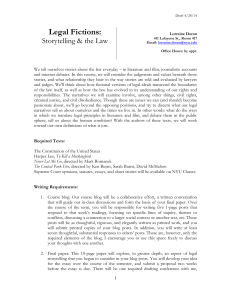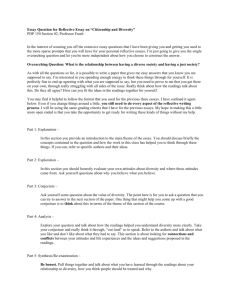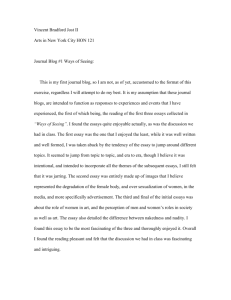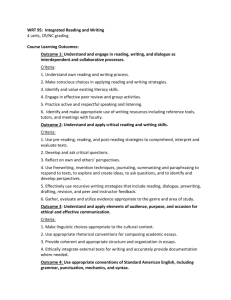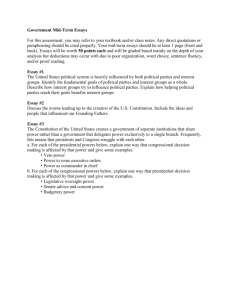University of Washington Department of Communication
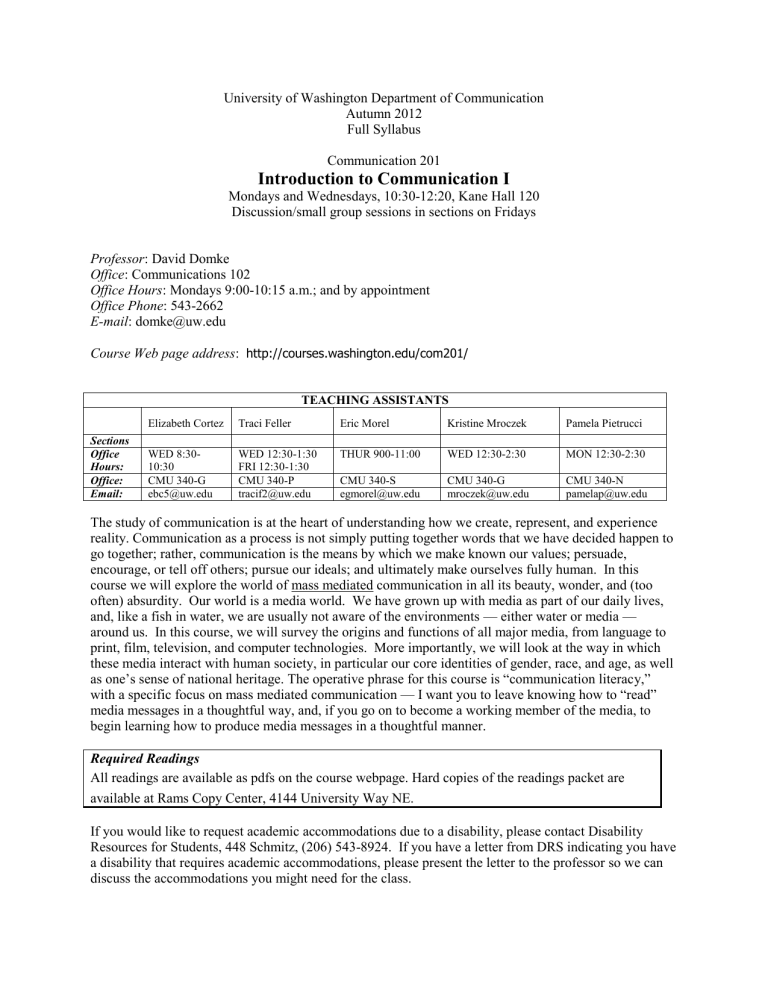
University of Washington Department of Communication
Autumn 2012
Full Syllabus
Communication 201
Introduction to Communication I
Mondays and Wednesdays, 10:30-12:20, Kane Hall 120
Discussion/small group sessions in sections on Fridays
Professor : David Domke
Office : Communications 102
Office Hours : Mondays 9:00-10:15 a.m.; and by appointment
Office Phone : 543-2662
E-mail : domke@uw.edu
Course Web page address : http://courses.washington.edu/com201/
TEACHING ASSISTANTS
Elizabeth Cortez Traci Feller Eric Morel Kristine Mroczek Pamela Pietrucci
Sections
Office
Hours:
WED 8:30-
10:30
Office:
Email:
CMU 340-G ebc5@uw.edu
WED 12:30-1:30
FRI 12:30-1:30
CMU 340-P tracif2@uw.edu
THUR 900-11:00
CMU 340-S egmorel@uw.edu
WED 12:30-2:30
CMU 340-G mroczek@uw.edu
MON 12:30-2:30
CMU 340-N pamelap@uw.edu
The study of communication is at the heart of understanding how we create, represent, and experience reality. Communication as a process is not simply putting together words that we have decided happen to go together; rather, communication is the means by which we make known our values; persuade, encourage, or tell off others; pursue our ideals; and ultimately make ourselves fully human. In this course we will explore the world of mass mediated communication in all its beauty, wonder, and (too often) absurdity. Our world is a media world. We have grown up with media as part of our daily lives, and, like a fish in water, we are usually not aware of the environments — either water or media — around us. In this course, we will survey the origins and functions of all major media, from language to print, film, television, and computer technologies. More importantly, we will look at the way in which these media interact with human society, in particular our core identities of gender, race, and age, as well as one’s sense of national heritage. The operative phrase for this course is “communication literacy,” with a specific focus on mass mediated communication — I want you to leave knowing how to “read” media messages in a thoughtful way, and, if you go on to become a working member of the media, to begin learning how to produce media messages in a thoughtful manner.
Required Readings
All readings are available as pdfs on the course webpage. Hard copies of the readings packet are available at Rams Copy Center, 4144 University Way NE.
If you would like to request academic accommodations due to a disability, please contact Disability
Resources for Students, 448 Schmitz, (206) 543-8924. If you have a letter from DRS indicating you have a disability that requires academic accommodations, please present the letter to the professor so we can discuss the accommodations you might need for the class.
Introduction week
September 24 to 28
Week One
October 1 to October 5
Week Two
October 8 to 12
2
Course Readings Schedule
Childhood memories, syllabus, what is communication?
1) Orenstein, P. (2006). “What’s wrong with Cinderella?” New York Times ,
December 24, 9 pages.
2) Maher, J. K., Herbst, K. C., Childs, N. M., & Finn, S. (2008). “Racial stereotypes in children’s television commercials.” Journal of Advertising
Research , pp. 80-93.
3) Reals, T. (2010). “Bert and Ernie gay? Apparently not.” CBS News,
October 26, 2010, 2 pages.
4) Doucleff, M. (2012). “Anatomy of a tear-jerker.” Wall Street Journal ,
February 11, at http://on.wsj.com/QewpR1
5) Slatalla, M. (2008). “I think this song is about me.” New York Times , March
27, 3 pages.
6) Singer, N. (2011). “On campus, it’s one big commercial.” New York Times ,
September 10, 8 pages.
7) Rossmeier, V. (2009). “Is the Internet melting our brains?” salon.com,
September 19, 4 pages.
8) Stephens, M. (1998). “Which communications revolution is it anyway?”
Journalism & Mass Communication Quarterly , 75(1), pp. 9-13.
Mass communication, culture, and society: Perspectives
1) Chaffee, S. H., & Metzger, M. J. (2001). “The end of mass communication?”
Mass Communication & Society , 4(4), pp. 365-379.
2) Smith, L. K. (2002). “‘Deviance’ & discourse: How readers respond to one man’s editorial: A framing analysis of e-mails following the September 11 th attacks.” Unpublished manuscript, pp. 2-33.
3) O’Flynn, S. (2005). “Ticket to a queer planet? Communication issues affecting young lesbian and gay people.” In Talking Adolescence , A.
Williams & C. Thurlow (Eds.). New York: Peter Lang, pp. 147-161.
4) Im, S. (2000). “About face: How sex and race are dividing Asian
Americans.”
The Seattle Weekly , August 24, pp. 21-25.
5) Durham, M. G. (1999). “Girls, media, and the negotiation of sexuality: A study of race, class, and gender in adolescent peer groups.” Journalism &
Mass Communication Quarterly , 76(2), pp. 193-216.
6) Carr, N. (2008). “Is Google making us stupid?” Atlantic Monthly ,
July/August, 7 pages.
American society, free speech, and news
1) Lemann, N. (2006). “The Murrow doctrine.” The New Yorker , January 23-
30, pp. 38-43.
2) Entman, R. (1991). “Framing U.S. coverage of international news:
Contrasts in narratives of the KAL and Iran Air incidents.” Journal of
Communication , 41(4), pp. 6-27.
3) Zachary, G. P. (2006). “A journalism manifesto.”
AlterNet , February 9, 2 pages.
4) Stocking, S. H., & Holstein, L. W. (2009). “Manufacturing doubt:
Journalists’ roles and the construction of ignorance in a scientific controversy.” Public Understanding of Science, 18(1), pp. 23-42.
5) Kerry, J. F., & Obama, B. (2007). “Why minority-owned media matters.”
Boston Bay-State Banner , October 25, 2 pages.
Week Three
October 15 to 19
Week Four
October 22 to 26
Week Five
October 29 to November 2
Week Six
November 5 to 9
3
Journalism in the 21 st century
1) Shirky, C. (2009). “Newspapers and thinking the unthinkable.” Shirky.com,
March 13, 5 pages.
2) Hermida, A. (2010). “Rethinking the role of the journalist in the participatory age.” MediaShift, July 9, 2 pages.
3) Rosen, J. (2008). “If bloggers had no ethics blogging would have failed, but it didn’t. So let’s get a clue.” PRESSthink.org, September 18, 2 pages.
4) Martin, J. (2011). “Influential Seattle blogger inflames left and right alike about Israeli security issues.” Seattle Times , September 12, 4 pages.
Mass communication: Movies and radio
1) Holmes, A. (2012). “White until proven Black: Imagining race in Hunger
Games.”
The New Yorker , March 30, 4 pages.
2) “The Godfather Wars” (2009). Vanity Fair , March, 270-283, 326-329.
3) Berg, C. R. (1998). “Stereotyping in films in general and of the Hispanic in particular.” In
Latin Looks: Images of Latinas and Latinos in the U.S.
Media , C. E. Rodriguez (Ed). NY: Westview Press, pp. 104-120.
4) Irvine, M. (2012). “Digital piracy: Youth shaping future of online TV, movies, music.” Salt Lake Tribune , February 18, 2 pages.
5) Ball, S. (2009). “Hollywood, stop hazing sorority girls.” Newsweek ,
September 11, 3 pages.
6) Hankin, K. (2007). “And introducing…The female director: Documentaries about women filmmakers as feminist activism.”
NWSA Journal , 19(1), pp.
59-88.
7) Ahrens, F. (2001). “Don’t touch that dial: Why FM radio sucks.” The
Washington Monthly , November, pp. 1-4.
8) Jenkins, H. (2010). “The reconfigurable culture of contemporary music: An interview with Aram Sinnreich (Part One).” HenryJenkins.com, September
3, 3 pages.
Words and images: Television
1) Smolkin, R. (2007). “What the mainstream media can learn from Jon
Stewart.”
American Journalism Review , April/May, 12 pages.
2) Martin, C. E. (2007). “After laughter, action.” Baltimore Sun , January 7, 2 pages.
3) Boyer, P. (2011). “Bill O’Reilly’s civil war.” Newsweek/thedailybeast,
September 18, 6 pages.
4) Pritchard, D., & Stonbely, S. (2007). “Racial profiling in the newsroom.”
Journalism & Mass Communication Quarterly , 84(2), 231-248.
5) NAACP. (2008). “Out of focus: Out of sync, take 4.” NAACP Report,
December, 1-40.
6) Kardos. M. (2011). “Writing the Jersey Shore in the age of Reality TV.” www.themillions.com
, September 13, 4 pages.
7) Chito Childs, E. (2012). “Examining the Jeremy Lin phenomenon through a critical lens.” FlowTV, February 27, 8 pages.
Playing media: Video games
1) Anderson, S. (2012). “Just one more game …” New York Times , April 4, 12 pages.
2) Bissell, T. (2012). “Thirteen ways of looking at a shooter.” Grantland. July
4
Week Seven
November 12 to 16 (no class on
Nov 12)
Week Eight
November 19 to 23 (no sections on Nov 23)
Week Nine
November 26 to 30
12, 6 pages.
3) McGonigal, J. (2010). “Gaming can make a better world.” TED.com, March
(20 min.). Watch it at http://bit.ly/aDmAYR
4) Nakamura, L. (2009). “Don’t hate the player, hate the game: The racialization of labor in World of Warcraft.” Critical Studies in Media
Communication , 26(2), pp. 128-144.
5) Parker, J. (2009). “School of rock.” Atlantic Monthly , March, 36-38.
The convergent world: Internet
1) Rheingold, H. (1993). Virtual community: Homesteading on the electronic frontier . Harper Perennial: New York, (electronic version = http://www.rheingold.com/vc/book/), pp. 1-37.
2) Grossman, L. (2010). “Mark Zuckerberg— Time ’s person of the year 2010.”
Time , December 15, 16 pages.
3) Ottalini, D. (2010). “Students addicted to social media - New UM study.”
NewsDesk.UMD.edu, April 21, 3 pages.
4) Tracy, M. (2012). “The tweeps on the bus: How buzzfeed is remaking campaign coverage.” The New Republic , August 24, 5 pages.
5) Halpern, S. (2010). “The ipad revolution.” New York Review of Books , June
10, 6 pages.
6) Nick (2012). “How to go viral on YouTube: Profiles in video marketing.”
Incomediary.com, May 1, at http://bit.ly/RQif3p
7) Sterne, J. (2012). “What if interactivity is the new passivity?” FlowTV,
April 9, 5 pages.
8) Cohen, N. (2011). “Define gender gap? Look up Wikipedia’s contributor list.”
New York Times , January 31, 4 pages.
Monies: Advertising and Ownership
1) Leiss, W., Kline, S., & Jhally, S. (1986). Social communication in advertising.
New York: Methuen, pp. 149-174.
2) Steinem, G. (1990). “Sex, lies, and advertising.” Ms . (July/August), pp. 18-
28.
3) Ting, R. (2012). “Why mobile will dominate the future of media and advertising.” The Atlantic , June 6, 3 pages.
4) Newman, N. (2011). “Racial and economic profiling in Google ads: A preliminary investigation (updated).” huffingtonpost.com, September 20.
Read at http://huff.to/qOCDvC
5) McChesney, R. W. (1998). “The political economy of global communication.” In Capitalism and the information age: The political economy of the global communications revolution , R. McChesney, E. M.
Wood, & J. B. Foster (Eds.). New York: Monthly Review Press, pp. 1-26.
6) Ritholtz, B. (2012). “Media consolidation: The illusion of choice.” The Big
Picture, July 16, at http://bit.ly/Qpb70N
7) Copps, M. J. (2007). “Democracy and media.” Seattle Times , September 9,
3 pages.
Free speech and international communication
1) Stone, G. R. (2005). “What you can’t say will hurt you.” New York Times ,
August 15, 2 pages.
2) Calvert, C. (1997). “Hate speech and its harms: A communication theory perspective.” Journal of Communication, 47(1), pp. 4-19.
Week Ten
December 3 to 7
5
3) Lohr, S. (2010). “How privacy vanishes online.” New York Times , March
16, 3 pages.
4) Poniewozik, J. et al. (2005). “The decency police.” Time , March 28, 7 pages.
5) Kaplan, R. (2009). “Why I love Al Jazeera.” Atlantic Monthly , October, 2 pages.
6) Skinner, D. (2000). “McLuhan’s world—and ours.” Public Interest , volume
138, pp. 52-64.
The global media village
1) Gerbner, G. (2002). “The cultural environment movement.” In Living In the
Information Age , E. P. Bucy (Ed.). Belmont, California:
Wadsworth/Thomson Learning, pp. 144-149.
2) Hutcheon, D. (2002). “Mixing up the world’s beat.” Mother Jones ,
July/August 2002, pp. 74-75.
3) Katayama, L. (2010). “Meet Jake Adelstein, a Jewish reporter who thinks like a Japanese gangster.” BoingBoing.net, March 9, 4 pages.
4) Gladwell, M. (2005). “Brain candy.” The New Yorker , May 16, 4 pages.
6
Grading System
The course grade will consist of several components, added together and converted into a decimal grade through a scale that begins with the average of the five highest scores in the class. Course points are spread over two writing assignments, three exams, and various forms of participation in the discussion sections on Fridays. In this class, you will be challenged to think clearly and critically and to express this thinking through exams, written papers, and small-group discussions. Incompletes for the course are not given except in highly unusual circumstances.
Participation (in discussion sections)
Media analysis essay #1
Media analysis essay #2
Exam #1
Exam #2
Exam #3
……… 40
..….… 90
..……. 90
..……. 60
..……. 60
…..…. 60
TOTAL 400
Potential extra credit
……... 4
Examinations
There are three examinations: exam #1 during class time on Wednesday, October 17; exam #2 during class time on Wednesday, November 7; and exam #3 during class time on Wednesday,
December 5. All exams will cover assigned readings and lectures. Early exams or make-up exams rarely will be given, and only to students who have unavoidable conflicts—that can be documented— with the exam time. The exams will consist of multiple-choice and short-answer questions. Approximately one week before each exam students will be given a study guide.
Class Attendance
Studies have shown that attending class is the most influential factor in learning course material. We will spend most of the class periods discussing material not covered directly in the readings; rather, we will use the readings as a jumping-off point for further learning. In particular, many of the key concepts for the course assignments are not contained in the readings and will be discussed only in lectures or sections. If you miss lectures, you should get (1) notes from another student and (2) copies of the overheads from the course Web page. Then you are welcome to talk to the professor or a TA to clarify the concepts.
Discussion Sections on Fridays
This course meets Mondays and Wednesdays for lectures, and Fridays for discussion sections in much smaller groups. Teaching Assistants will lead these sections, and will provide students with a
“section syllabus” on the first Friday of the quarter.
C.L.U.E. Study Sessions
The Center for Learning and Undergraduate Enrichment is run by the Office of Undergraduate
Education, and its goal is to provide students with study opportunities in evenings. For this class, a
Teaching Assistant will lead study/review sessions the evening before each of the three exams. The TA will be available to answer questions and clarify ideas. Information on the date, time, location of each review session will be announced as we get close to each exam. Sessions will also be live-streamed for students who can’t or don’t wish to attend in person.
7
Extra Credit
During the quarter, you will be given a chance to earn extra credit. Each opportunity will be worth 2 points of class credit. These points will be assigned after the course scale is developed, so that anyone who chooses not to do these things will not be disadvantaged.
1. Opportunity 1: Participate in a research study conducted by a graduate student or faculty member. Such participation, if it becomes available , will involve 30-60 minutes of your time, and will be something you can fit into your schedule. More information on this opportunity if and when it develops. So, to be clear, this opportunity may happen.
2. Participate in “The Hope Covenant” project, in which you apply something learned in class this quarter to make the world a better place. It could be creating a new media message, choosing to stand against some damaging cultural ideologies, being more thoughtful about how you consume media messages, and so on. You will need to write a one-page, single-spaced paper talking about what you did, and reflecting on the experience. This can be turned in to your TA sometime between 9 am on Nov. 26, and 12 noon on Nov. 30. Nothing early or late will be accepted. So, to be clear, this is a for-sure opportunity to earn extra credit.
Course Grading Scale
Course grades will be calculated according to the following procedure.
1. Students’ points from the (a) three exams, (b) two essays, and (3) participation in TA-led sections will be added together. The total possible points is 400.
2. The actual top five scores among students in the class will be identified and averaged together.
Just as a point of reference, in both fall 2011 and fall 2010 quarters, the average of the top five scores was 381; in fall 2009 quarter, the average of the top five scores was 387. It is likely that the average of the top five scores for the course this quarter will be in the area of these examples.
3. The score that is the average of the top five scores in the class will be assigned a grade of 4.0 on the UW grading scale.
4. Next, a calculation will be done to determine the score point total that is 60 percent of the top score. Whatever this point total is will become the lowest passing grade on the UW grading scale — that is, a 0.7. For both fall 2011 and fall 2010 quarters, that point total was 228; for the fall 2009 course, that point total was 232.
5. These calculations, then, identify the number of COM 201 course points that are equivalent to a 4.0 and 0.7 on the UW grading system. From here it is basic mathematics to determine where a student’s specific course point totals falls on this range.
6. A few examples from fall 2011:
Students with 360-364 points received a 3.6 course grade.
Students with 333-336 points received a 3.0 course grade.
Students with 314-318 points received a 2.6 course grade.
Students with 272-276 points received a 1.7 course grade.
8
Media Analysis Essays
In these assignments, you will be asked to investigate media messages in depth: to take the conceptual ideas and analytical skills we have been discussing and developing over the quarter and apply them to the kinds of media content you use every day. We are looking for both critical thinking and competent writing skills — common requirements for college-level work. Grading of these assignments will be according to the following scale:
5 points Format : Is the essay put together, generally, with appropriate grammar, syntax, spelling, and use of language? The assignment should be a presentable, readable essay.
60 points Analysis : Do you think both analytically and creatively using the concepts we’ve discussed in class? Rather than simply making statements of what you think, are you explaining/elaborating your thinking (that is, telling us why you think what you do)? Your perceptions based on presented evidence from the news article and accompanying blogs (Assignment One) or from your observations/interviews of people (Assignment Two) is particularly important.
25 points Discussion : Consider thoughtfully the implications for society, media, and how we understand the world. Do you make a good argument for what you say? Again, are you explaining your thinking?
Media Analysis Essays
There are two media analysis essays in this course. The f irst is due in Week 4 in Friday sections (October 26). The second is due in Week 7 in Friday sections (November 16). In each instance, here is how these assignments will proceed:
1. Teaching Assistants will choose a group of media messages to be the focus of the assignments, and will inform students of these messages two weeks prior to the Essay 1 due date and three weeks prior to the Essay 2 due date.
2. Students will have the opportunity to select which one of the media messages (of the ones chosen by the TAs) they wish to focus on for the assignment.
3. Students will complete the assignment, paying specific attention to the directions and questions that follow below.
4. Students will turn in their essays on the due date in sections.
Essay format:
All essays must be typed, double-spaced, in 12-point type, with margins of 1 inch, and 3 pages in length, plus or minus a half page. At the top of the paper, please put your name and student ID number.
Essays cannot be turned in via email. Essays that do not meet these format guidelines will be penalized
5 points. Essays that are turned in late will lose 5 points per weekday that they are late.
9
Media Analysis Essay #1: The Framing of News
In class we will discuss (a) the types of values that journalists often emphasize, usually without even being aware of it, when writing or producing stories, and (b) the ways in which online blogs are impacting the news environment and public conversation. Drawing upon this information discussed in class, for this essay you are to analyze a news story and a set of related blog posts, to draw some interpretations, and to explain your thinking.
Step 1: The Teaching Assistants will choose three articles, on differing topics, from daily, metropolitan U.S. newspapers (for example, Seattle Times, Tacoma News Tribune, Washington
Post, New York Times). The story will be recent (after Aug. 31, 2012), will be on Page A-1 above the fold, and it will be continued on an inside page . In other words, it will be a news story that a major news organization thought was pretty darn “newsworthy.” Next, the TAs will choose three blog posts related to each of the articles and the topics emphasized in the articles.
The chosen blog posts will reflect differing perspectives. You will be informed of these articles + blog posts two weeks prior to the essay due date, and you will have the opportunity to choose one of the articles + its three related blog posts for this assignment.
Step 2: Using Herbert Gans’ enduring values of journalists (ethnocentrism, etc.), do you detect these values within the “framing” of the newspaper story? (It is unlikely that all the values are present in the newspaper story, but it is a certainty that at least some are present. Focus on the ones you think are most apparent in the article). By the focus of the newspaper story or the way information is conveyed through the selection of quotes, verbs, adjectives, and adverbs, are particular values emphasized, either explicitly or implicitly? You must point out specific elements of the article when arguing for the presence of any of the enduring values.
This part of the analysis does not include the blog posts; focus only on the newspaper article.
Step 3: Drawing upon the lecture discussion about ways that online blogs are impacting news and the public conversation, what do you see as the primary “influencer techniques” that these posts are offering? Specifically, how are the posts attempting to impact news and the public conversation on these topics? (It is unlikely that all the techniques are the goals of each of the posts, but it is a certainty that at least some techniques are present in each post. Focus on the ones you think are most apparent). Examine closely the claims that the blog posts are making; what do the writers seem to be attempting to accomplish? You must point out specific elements of the posts when arguing for the presence of any of the influencer techiques.
This part of the analysis does not include the news article; focus only on the blog posts.
Step 4: Based on your analysis for this assignment and our discussion of news media and blogs in class, which of the following eras of public debate do you think are better for democracy: the
1950s, when news and public debate was limited to three TV networks, local newspapers, and political officeholders, or now, when news and public debate includes several TV networks, newspapers on- and offline, political officeholders, and lots of blogs. Do not just give a simple
“of course then/now is better” answer. Think about why one of the eras was or is better for democracy in general. Explain your thinking. Which era you pick is not important; what’s important is your explanation of why you think one era was/is better.
10
Media Analysis Essay #2: Our Interactions with Media
In this course we will discuss four ways to think about the role of media in society — from the perspectives of (1) media effects, (2) cultural studies, (3) critical theory, and (4) medium theory.
Each of these offers a particular way of thinking about the role that media messages serve in a mass, modern society such as the United States. To be clear, these perspectives are not contradictory; each offers something insightful about the role of media. The better our grasp of these differing perspectives, the more complete our understanding of the ways that media matter in society.
One way for us to gain insight into these perspectives is to examine how people interact with media messages. How do people respond when they watch television programs? Or read a newspaper or listen to music? While watching a movie, for example, it is common for people to laugh, cry, get angry, fall asleep, talk to others, eat, drink, go to the restroom, lean forward, kick back, exercise, and so on. The point here is that people interact with media messages in ways that are not a whole lot different than ways in which we interact with each other. Further, when we take the time (1) to observe how people interact with media messages, and (2) to ask people about media messages, we begin to gain significant insight into the role of media messages in society. Such insight is the goal of this assignment.
Step 1: The Teaching Assistants will choose a small number of popular video games. You will be informed of the selected video games three weeks prior to the essay due date, and you will have the opportunity to choose one of the video games for this assignment.
Step 2: Find a group of people (2 or 4 people) who are willing to play the video game for the first time. Next, find one person who can explain how to play the game. Then, have this group play the game for roughly three hours. Tell them three things: (1) you would like to observe them as they play the video game; (2) you will ask them a couple questions after they’ve played the game;
(3) you will be writing a class paper based on your observations and their responses. You must tell them these things: to not do so is a violation of their rights as subjects in research. In the paper, discuss in one paragraph the personal characteristics of the members of your group — what are their ages, genders, ethnicity/race, professions if they work, and anything else you think relevant. Note:
• COM 201 students cannot observe the same people; each student must find “own” people
• COM 201 students cannot observe people who are enrolled in this class
Step 3: Observe them interacting with the video game. Don’t be painfully obvious about your observations; in other words, make sure they’re focused on the game, not you. Sit off to the side, somewhere you can observe them but they are not looking right at you. Note any behaviors, reactions, body language, talking, and so on that these people engage in while they play the game.
In the paper, summarize their actions, focusing on the ones that you found most interesting. What did these actions suggest to you about the ways in which these people were interacting with this media message? Were there any actions common across people?
Step 4: After the three hours is over, interview everyone at once, as a group. Begin by asking these questions: “What about this video game was fun, and why?” And then ask “What about this video game bothered you, and why?” Make sure that each person has a chance to answer.
Then ask at least five other questions that you come up with. You should record or write down
11 responses to all questions. Of course, you might come up with many questions, and that’s fine.
In the paper, focus on three questions — one of the ones noted above plus any two that you created. Summarize people’s responses to these questions. How were individuals similar or different in their responses? Use at least a couple quotations from the people. Speculate — based on your opinion or things that the people said — of reasons that members of the group responded in either similar or different ways.
Step 5: Based on your observations and interviews, discuss which of the four perspectives about the role of media — media effects, critical theory, etc. — is most helpful in explaining how your group members interacted with the video games. Which perspectives best explains how they reacted and what they said? Explain your thinking.



